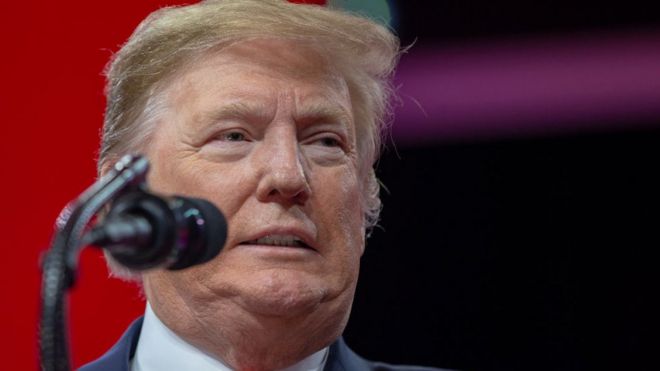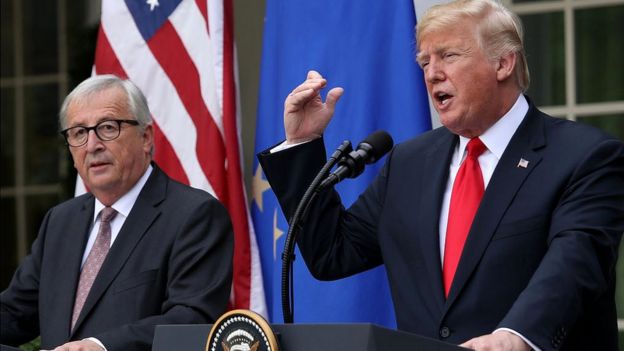 GETTY IMAGES
GETTY IMAGES
The US trade gap with the rest of the world jumped to a 10-year high of $621bn (£472.5bn) last year, dealing a blow to President Donald Trump's deficit reduction plan.
The trade deficit is the difference between how much goods and services the US imports from other countries and how much it exports.
Reducing the gap is a key plank of Mr Trump's policies.
But in 2018, the US exported fewer goods compared with how much it bought.
Mr Trump claims that the US is being "ripped off" by other nations and wants countries to lower their tariffs on US goods and buy more of them.
However, official data shows that while exports of US goods and services rose by $148.9bn last year, imports jumped by $217.7bn.
It means that the gap is the widest since 2008, when the global financial crisis hit and the US fell into recession.
The deficit in goods and services during December also hit a near 10-year high of $59.8bn.
Exports to the rest of the world fell 1.9% to $205.1bn, while imports rose by 2.1% to $264.9bn.
'Tariff man'
The US is currently locked in a trade battle with China over what it claims are unfair trade practices, resulting in tit-for-tat tariff increases on each others' goods.
Both nations are in discussions and there is speculation they could reach an agreement by the end of March.
New data shows that the trade gap between the US and China widened last year by $43.6bn to $419.2bn as exports of American products and services fell, but imports from China rose.

Analysis: Michelle Fleury, BBC North America business correspondent
It was one of Donald Trump's signature campaign promises.
Back in June 2016, he stood before a large crowd in Monessen, Pennsylvania and said that as President, he would reduce America's ballooning trade deficit.
 GETTY IMAGES
GETTY IMAGES
He called it "a political and politician-made disaster" and said "it can be corrected".
Only it hasn't exactly turned out that way.
Last year, Mr Trump introduced tariffs on steel and aluminium from around the globe and on a range of imports from China.
The idea was that the tariffs would make imports more expensive, thereby discouraging Americans from buying foreign goods and services and shrinking the trade deficit.
But the opposite has happened.
Instead, Donald Trump goes into the presidential re-election race having failed to deliver on his campaign promise to close the US trade deficit.
Part of the problem is Mr Trump's own tax policies. They boosted US consumption and a lot of that spending went abroad.
This happened as growth was slowing in other parts of the world, contributing to a rising dollar. That made US exports more expensive and less competitive.
Of course, an economic downturn would help reduce the trade deficit.
But who wants that?

Mr Trump warned in December that if the two countries failed to reach an agreement on trade, he would take action, dubbing himself "a Tariff Man".
'National security'
The deficit between the US and the European Union also increased in 2018, up by $17.9bn to $169.3bn.
Following the same trend as with China, US export growth to the EU was eclipsed by imports of European goods and services to America, which last year rose to $487.9bn.
 GETTY IMAGES
GETTY IMAGES
Following a spat between the US and the EU when America lifted tariffs on steel and aluminium, Mr Trump and European Commission President Jean-Claude Juncker last year reached a truce.
However, Mr Trump may choose to lift tariffs on European cars and parts after the US Commerce Department produced a report examining whether the imports threaten national security.
Meanwhile, US Trade Representative Robert Lighthizer and EU Trade Commissioner Cecilia Malmstrom are meeting on Wednesday in Washington, where the issue of allowing America's agriculture industry access to Europe is expected to be discussed.
No comments:
Post a Comment